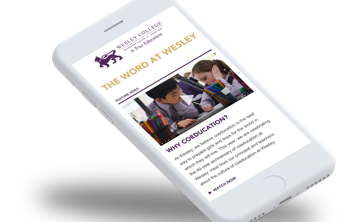
For Milica Savic, one of the key lessons from her French virtual classroom experience has been that online and on-campus programs can both support effective learning.
When I first started planning my Languages program for the virtual classroom environment, I have to admit I felt some trepidation. That’s partly because I thought of it in an ‘either/or,’ zero-sum way: more online learning equalled less of the face-to-face learning that is so fundamental to Languages learning. What our virtual classroom experience showed me, though, was that, in the words of David Nunan, ‘We need both in-class and out-of-class learning…to maximise the learning potential for our students.’
Put simply, Languages students need both the structure and perdictability of classroom routines and the open-endedness and felixibility of online opportunities. Nunan again: ‘In-class and out-of-class learning are not “either/or” options. Both have their own particular contributions to make to the learning process.’
A travel ban in March
As we prepared for our first virtual classes as the Term 1 break approached, my plan for Year 9 French was for students to create a holiday proposal to visit a French-speaking country. What could go wrong?
Students had online access to an incredible resource: French websites giving access to information on current festivals, concerts, cultural sites, accommodation options and weather, all of which swiftly replaced their content with travel cautions and COVID-19 warnings. It quickly became clear that I needed to think carefully about how my students could draw on their previous on-campus learning to support their current online learning.
Combining existing resources, learning routines and online tools
The first step in working out what resources, learning habits and online tools worked best for my students was to come back to the core knowledge that I wanted them to develop. I could then scaffold vocabulary and start using it in context. We started with several lessons using online resources that we’d already been using on campus for some time. To check how we were travelling, I asked the students to fill out a Google questionnaire to reflect on their engagement and progress so far. I found that textbook activities provided the least enjoyment in the remote learning setting, while only 3.6 per cent of students nominated live lessons as their least enjoyable. That finding led me to reformat our initially asynchronous small group chats as live chats.

Students reported that textbook activities provided the least enjoyment in the remote learning setting
What would have been a simple show of hands in an on-campus class became an efficient online straw poll. I used the data to inform my next planning steps and to create a self-paced project. To design the project task I used the ‘meaningful assessments’ GRASPS approach explained by Grant Wiggins and Jay McTighe in Understanding by Design. GRASPS requires students to produce work with a clear goal, role, audience, situation, performance type and standards for success. I provided each student with a booklet of resources which would give them the support to create their holiday proposal to a French-speaking country with specific clients in mind. In a time where students were facing great uncertainty and confusion, engaging their imaginations and hope for the future seemed a step in the right direction.
Checking in with students
One of the great things about face-to-face learning in an on-campus environment is that it’s easy to check in with students. That can be a simple show of hands but sometimes it’s even just a matter of picking up on the subtle non-verbal cues that can indicate engagement and understanding.
By adapting our online learning approach to reflect our existing on-campus classroom routines and habits I was able to ensure that my students still had plenty of opportunities for regular check-ins and live lessons still enabled them to use topic-related language in context and to ask questions. Getting their feedback was simply a matter of translating the process of a quick straw poll into MS Forms. And their feedback? They enjoyed the option to work offline for some activities and to allocate their time according to their own needs. Empowering them to make these decisions for themselves in a time where many choices were taken away was vital to my approach to the design of the self-paced project.

Regular and uncomplicated check-ins provided quick and valuable feedback from students
Small-group discussion
Halfway through their preparation, students took part in smaller live meetings with their class peers and me, to share their responses to four questions:
- Which country did you choose?
- What’s one interesting thing you’ve learnt about this country?
- What have you enjoyed about this task?
- What have you found challenging about this task?
The smaller live meetings required students not only to reflect on their work but also to listen respectfully to others’ opinions and offer suggestions and support. It was students’ overwhelmingly consistent response to the fourth question that was both surprising and motivating. Their greatest challenge was taking the abundance of research in English and paring down the language to convey the same meaning using their existing French language. Strategies that students had become accustomed to using in class – such as linking verbs with their approximate synonyms – were easily facilitated through MS Teams Group channels. What students identified here was not only a challenge of this task but of Languages learning more generally – the need to view translation as the transmission of meaning and not simply translating words. This was an important shift in their conceptual understanding of language: c'est magnifique!

Zofia Dabkowska’s holiday proposal to visit Monaco. Expect strong interest in visits to Monaco when travel bans are lifted.
On their return to on-campus classroom learning, students will incorporate the work they completed while working remotely into presentations to small groups of students in an attempt to ‘sell’ their holiday proposals. Thanks to their open mindedness during this period of remote learning, I have no doubt that my Year 9 students are returning to my classroom with greater confidence, agency and motivation.
And what of my return to the classroom? I’ve had to question my zero-sum assumption: is online learning and on-campus learning an either/or choice? My answer? Not remotely. Good learning has always involved a blend of the approaches that best meet the needs of students. Sometimes, that can even be a page from a textbook.
The task I and my colleagues now have is how to blend the range of effective online and on-campus learning experiences in a hybrid model to give students structured and authentic learning experiences that enable them to be their best. One thing is certain: in my hybrid approach I’ll still be taking straw polls using MS Forms and encouraging collaboration and support through MS Teams.
Milica Savic is a teacher of French at Wesley’s Elsternwick Campus.
You can find background about Grant Wiggins and Jay McTighe’s GRASPS approach here and examples here.
